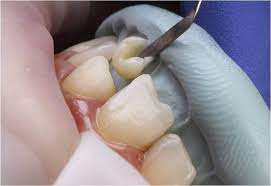Cementing plays a crucial role in dental bonding, ensuring that restorations such as crowns, bridges, veneers, and fillings stay securely attached to the natural tooth structure. It acts as a strong adhesive, providing a durable bond between the dental restoration and the tooth. This bonding process not only improves the functionality of dental work but also enhances the aesthetic appeal. In this article, we’ll explore the importance of cementing in Dental Bonding Cementing and how it contributes to the success of restorative treatments.
What is Dental Cementing?
Dental cementing is the process of using special adhesives (cement) to bond a dental restoration, such as crowns or veneers, to a prepared tooth. The cementing material must create a solid bond to ensure the longevity and stability of the restoration. These cements come in different varieties, each suited for different types of dental work.
Common types of dental cement include:
-
Resin-based cements: These offer strong bonding power and are often used for crowns and veneers.
-
Glass ionomer cements: Ideal for fillings, these also release fluoride, which helps in tooth remineralization.
-
Zinc phosphate cements: Known for their strength and durability, often used in crown placements.
-
Temporary cements: Used for temporary restorations, ensuring the tooth remains intact during treatment.
Choosing the right type of cement is key to achieving a strong and lasting bond.
How Cementing Affects Restoration Durability?
One of the most important factors in restorative dentistry is the durability of the restoration. The quality of cementing directly impacts how long a dental restoration will last, as it influences the bond between the tooth and the restoration. Proper cementing prevents the restoration from loosening or falling out over time.
Factors that affect cementing durability:
-
Bond strength: A strong bond reduces the risk of the restoration coming loose or dislodging.
-
Cement setting time: Proper curing ensures the cement hardens effectively, providing lasting support.
-
Material compatibility: Ensuring the cement is compatible with both the tooth and restoration materials is essential for a secure bond.
By using high-quality cementing materials and following correct procedures, dental professionals can ensure the longevity of their patients’ restorations.
Cementing’s Role in Protecting the Tooth:
Dental cement acts as a barrier, protecting the natural tooth from further damage. By sealing the restoration securely to the tooth, cementing prevents bacteria, plaque, and other harmful substances from entering the tooth structure, which could lead to decay or infection.
How cementing protects the tooth:
-
Seals off gaps: Properly applied cement fills in any gaps between the restoration and the tooth, preventing the accumulation of harmful bacteria.
-
Prevents tooth decay: The sealed bond prevents plaque buildup that can cause cavities and decay around the restoration.
-
Enhances tooth strength: Strong bonding helps reinforce the tooth structure, preventing fractures or cracks.
This protective barrier is essential for maintaining the long-term health of the tooth and the restoration.
Aesthetic Benefits of Cementing in Dental Bonding:
Beyond function, dental bonding cement also enhances the aesthetic outcome of restorations. The cement used in dental bonding can be color-matched to the natural tooth, making crowns, veneers, and fillings virtually indistinguishable from the patient’s natural teeth. The result is a seamless, beautiful smile that boosts the patient’s confidence.
Aesthetic advantages of cementing include:
-
Color customization: Dental cement can be tinted to match the natural shade of the teeth, ensuring that restorations blend in seamlessly.
-
Smooth finish: Proper application of cement provides a smooth, polished surface for the restoration.
-
Natural appearance: High-quality cement ensures that the restoration looks natural and aesthetically pleasing.
This contributes not only to functional improvements but also to a more beautiful and confident smile.
The Role of Cementing in Minimizing Tooth Sensitivity:
Tooth sensitivity can be a common concern after restorative treatments, especially when the tooth structure is exposed. Cementing helps minimize sensitivity by providing a protective layer that shields the tooth from temperature changes and pressure. A well-bonded restoration ensures the tooth is less likely to react to hot or cold foods and beverages.
How cementing helps reduce tooth sensitivity:
-
Seals nerve endings: The cement forms a protective seal around the tooth, minimizing discomfort from external stimuli.
-
Prevents leakage: Proper cementing ensures there is no leakage of air, liquids, or food particles that could trigger sensitivity.
-
Increases comfort: With a secure bond, patients are less likely to experience discomfort from restored teeth.
This makes cementing an essential part of the overall comfort and success of the dental restoration process.
The Future of Dental Cementing:
With advancements in dental materials, the future of Dental Bonding Cementing Treatment is looking bright. New technologies are being developed to improve the strength, aesthetics, and ease of use of dental cements. From more durable bonding to faster curing times, these innovations will continue to shape the dental field.
Trends in the future of dental cementing:
-
Stronger materials: Researchers are working on developing cements with enhanced bonding capabilities and resistance to wear.
-
Faster curing times: With advances in curing technology, dental cement can set more quickly, reducing treatment times.
-
Eco-friendly materials: Sustainability is becoming a priority, and there is an increased focus on developing environmentally friendly cement options.
As dental bonding materials improve, patients can expect longer-lasting and more efficient treatments.
Conclusion:
Cementing plays a pivotal role in dental bonding, ensuring that restorations are securely attached to the tooth, improving functionality, durability, and aesthetics. From preventing decay and enhancing tooth protection to providing a natural-looking smile, the right cementing technique is crucial for the long-term success of dental treatments. As the field of restorative dentistry evolves, cementing will continue to be a fundamental element of achieving optimal dental results for patients.

